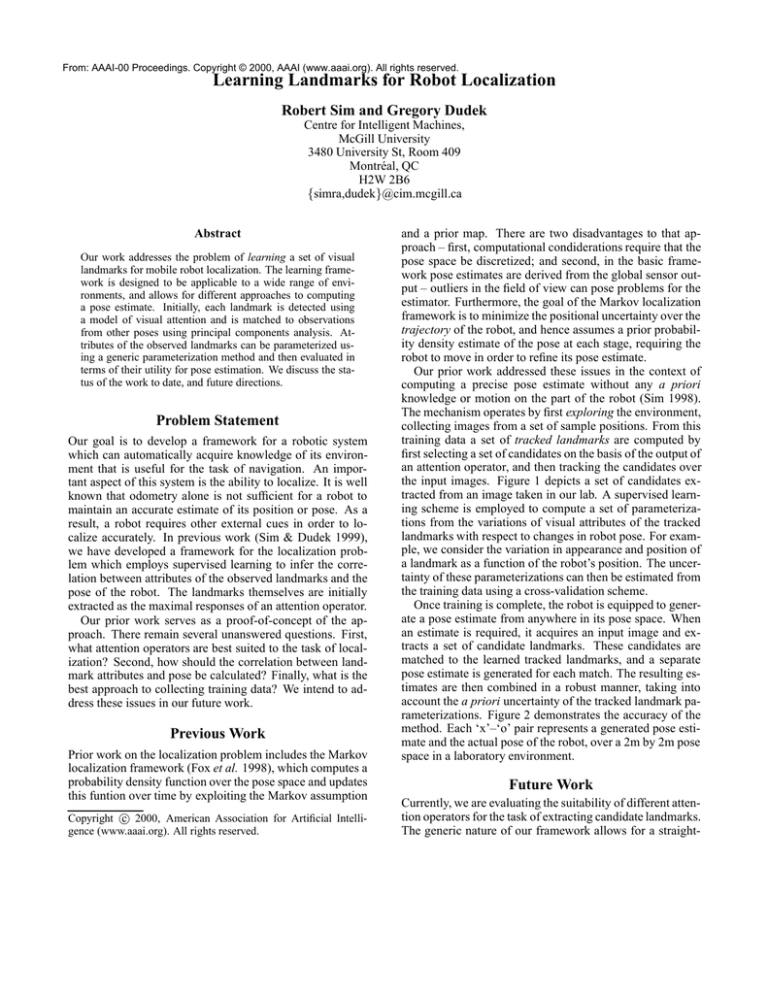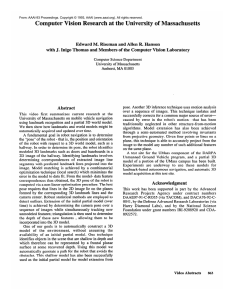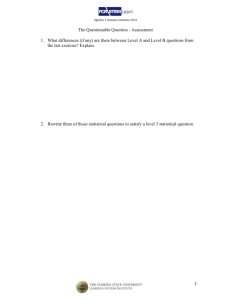
From: AAAI-00 Proceedings. Copyright © 2000, AAAI (www.aaai.org). All rights reserved.
Learning Landmarks for Robot Localization
Robert Sim and Gregory Dudek
Centre for Intelligent Machines,
McGill University
3480 University St, Room 409
Montréal, QC
H2W 2B6
{simra,dudek}@cim.mcgill.ca
Abstract
Our work addresses the problem of learning a set of visual
landmarks for mobile robot localization. The learning framework is designed to be applicable to a wide range of environments, and allows for different approaches to computing
a pose estimate. Initially, each landmark is detected using
a model of visual attention and is matched to observations
from other poses using principal components analysis. Attributes of the observed landmarks can be parameterized using a generic parameterization method and then evaluated in
terms of their utility for pose estimation. We discuss the status of the work to date, and future directions.
Problem Statement
Our goal is to develop a framework for a robotic system
which can automatically acquire knowledge of its environment that is useful for the task of navigation. An important aspect of this system is the ability to localize. It is well
known that odometry alone is not sufficient for a robot to
maintain an accurate estimate of its position or pose. As a
result, a robot requires other external cues in order to localize accurately. In previous work (Sim & Dudek 1999),
we have developed a framework for the localization problem which employs supervised learning to infer the correlation between attributes of the observed landmarks and the
pose of the robot. The landmarks themselves are initially
extracted as the maximal responses of an attention operator.
Our prior work serves as a proof-of-concept of the approach. There remain several unanswered questions. First,
what attention operators are best suited to the task of localization? Second, how should the correlation between landmark attributes and pose be calculated? Finally, what is the
best approach to collecting training data? We intend to address these issues in our future work.
Previous Work
Prior work on the localization problem includes the Markov
localization framework (Fox et al. 1998), which computes a
probability density function over the pose space and updates
this funtion over time by exploiting the Markov assumption
c 2000, American Association for Artificial IntelliCopyright gence (www.aaai.org). All rights reserved.
and a prior map. There are two disadvantages to that approach – first, computational condiderations require that the
pose space be discretized; and second, in the basic framework pose estimates are derived from the global sensor output – outliers in the field of view can pose problems for the
estimator. Furthermore, the goal of the Markov localization
framework is to minimize the positional uncertainty over the
trajectory of the robot, and hence assumes a prior probability density estimate of the pose at each stage, requiring the
robot to move in order to refine its pose estimate.
Our prior work addressed these issues in the context of
computing a precise pose estimate without any a priori
knowledge or motion on the part of the robot (Sim 1998).
The mechanism operates by first exploring the environment,
collecting images from a set of sample positions. From this
training data a set of tracked landmarks are computed by
first selecting a set of candidates on the basis of the output of
an attention operator, and then tracking the candidates over
the input images. Figure 1 depicts a set of candidates extracted from an image taken in our lab. A supervised learning scheme is employed to compute a set of parameterizations from the variations of visual attributes of the tracked
landmarks with respect to changes in robot pose. For example, we consider the variation in appearance and position of
a landmark as a function of the robot’s position. The uncertainty of these parameterizations can then be estimated from
the training data using a cross-validation scheme.
Once training is complete, the robot is equipped to generate a pose estimate from anywhere in its pose space. When
an estimate is required, it acquires an input image and extracts a set of candidate landmarks. These candidates are
matched to the learned tracked landmarks, and a separate
pose estimate is generated for each match. The resulting estimates are then combined in a robust manner, taking into
account the a priori uncertainty of the tracked landmark parameterizations. Figure 2 demonstrates the accuracy of the
method. Each ‘x’–‘o’ pair represents a generated pose estimate and the actual pose of the robot, over a 2m by 2m pose
space in a laboratory environment.
Future Work
Currently, we are evaluating the suitability of different attention operators for the task of extracting candidate landmarks.
The generic nature of our framework allows for a straight-
observations. In formulating a solution to such a problem,
one must consider seriously the issue of what constitutes a
good model of a landmark, as well as the costs associated
with physically moving the robot to new vantage points.
Our consideration of these issues will rely heavily on the
theoretical framework for inverse problem theory developed
by Tarantola (Tarantola 1986), Whaite’s approach to model
parameter estimation using active vision (Whaite & Ferrie 1990) and the approach to map-building developed by
Kuipers and Byun (Kuipers & Byun 1991), which constructs
local regions of reliability in the pose space.
We expect that a theoretically rigorous approach to the
problem of learning to estimate pose from visual landmarks
will lead to an implementation that is successful both experimentally and in practical settings.
Figure 1: A scene with extracted landmark candidates.
Acknowledgements
This work is funded by a PGS-B scholarship from the Canadian Natural Sciences and Engineering Research Council.
Pose estimates and corresponding ground truth
200
References
180
160
Y coordinates in cm
140
120
100
80
60
40
20
0
0
20
40
60
80
100
120
X coordinates in cm
140
160
180
200
Figure 2: A set of pose estimates obtained from a 2m by 2m
laboratory environment.
forward substitution of a new attention operator. The quality
of the results will be measured in terms of the raw accuracy
of the resulting pose estimation system, as well as its ability
to measure the uncertainty of the pose estimates.
In order to address the problem of selecting an appropriate attention operator, we will consider the prior work of
Shi and Tomasi (Shi & Tomasi 1994), which selects features
which are well disposed to tracking, Reisfeld et al. (Reisfeld, Wolfson, & Yeshurun 1995), which selects features
on the basis of symmetry, and Itti and Koch (Itti, Koch, &
Niebur 1998), which employs a variety of criterion in order
to select regions of high saliency.
Second, we are investigating alternative parameterization
paradigms. Our initial parameterization method linearizes
the joint data-pose space, and the results are very good
compared to the standard linear least-squares estimation approaches which treat the pose and data spaces as duals. We
are also considering non-linear parameterization approaches
such as neural networks and regularization.
Finally, we are considering the important problem of deciding what are the best poses from which to collect training
Fox, D.; Burgard, W.; Thrun, S.; and Cremers, A. B. 1998.
Position estimation for mobile robots in dynamic environments. In Proceedings of the 15th National Conference on
Artificial Intelligence (AAAI-98) and of the 10th Conference on Innovative Applications of Artificial Intelligence
(IAAI-98), 983–988. Menlo Park: AAAI Press.
Itti, L.; Koch, C.; and Niebur, E. 1998. A model of
saliency-based visual attention for rapid scene analysis.
IEEE Transactions on Pattern Analysis and Machine Intelligence 14:1254–1259.
Kuipers, B., and Byun, Y.-T. 1991. A robot exploration and
mapping strategy based on a semantic hierarchy of spatial
representations. Robotics and Autonomous Systems 8:47–
63.
Reisfeld, D.; Wolfson, H.; and Yeshurun, Y. 1995. Context
free attentional operators: the generalized symmetry transform. International Journal Of Computer Vision 14:119–
130.
Shi, J., and Tomasi, C. 1994. Good features to track. In
Proceedings of the Conference on Computer Vision and
Pattern Recognition, 593–600. Los Alamitos, CA, USA:
IEEE Computer Society Press.
Sim, R., and Dudek, G. 1999. Learning and evaluating visual features for pose estimation. In Proceedings
of the IEEE International Conference on Computer Vision(ICCV). Kerkyra, Greece: IEEE Press.
Sim, R. 1998. Mobile robot localization from learned
landmarks. Master’s thesis, McGill University, Montreal,
Canada.
Tarantola, A. 1986. Inverse Problem Theory. Amsterdam,
The Netherlands: Elsevier Science Publishers B. V.
Whaite, P., and Ferrie, F. P. 1990. From uncertainty to
visual exploration. In Proceedings of the 3rd International
Conference on Computer Vision.




